ARIAMNA CONTINO: THE FOREST IS DISORDER, ABUNDANCE AND CONFUSION
Cuban-born artist Ariamna Contino presents the exhibition Manigua at El Apartamento, in Spain to revisit the concept of “manigua”, a term historically used to refer to a tropical forest ecosystem.
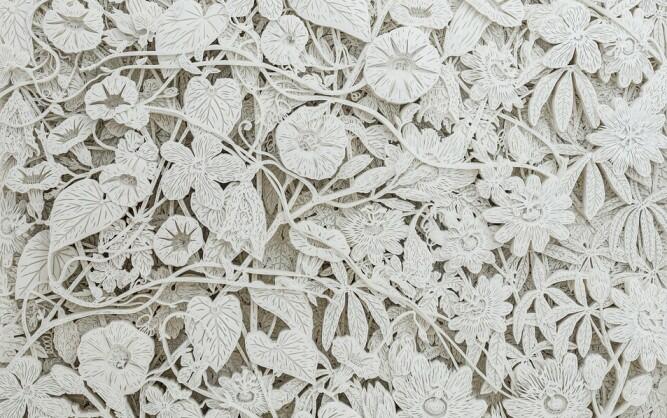
In her first solo show in Madrid, Ariamna Contino revisits the concept of “manigua,” whose etymological origins can be traced back to the Indigenous Taino language. Historically, this term has been used in Cuba to refer to a tropical forest ecosystem specific to the Caribbean. The primitive meaning of the word is “disorder; abundance of something; confusion.”
The artist presents an exhibition in the form of an extended essay in which she combines common knowledge, historical documents, traditional medicine, aesthetic reflections, and a vibrant process of interdisciplinary work. Her creative corpus finds installations, drawings, site-specifics, and oeuvres made on hand-cut paper. In its cultural sense, the exhibition focuses on the rite, identity, and myth. Contino is interested in drawing attention to resistance exercises within popular culture as a space for safeguarding the collective imagination and the political potential of unregulated knowledge.
-
Ariamna Contino. Enredadera. From the series Manigua 2024. Hand-cut paper, Fabriano Watercolor Cold Press cardboard 300 gsm, 160 x 160 x 8cm.
-
Ariamna Contino. Enredadera. From the series Manigua 2024. Hand-cut paper, Fabriano Watercolor Cold Press cardboard 300 gsm, 160 x 160 x 8cm.
-
Ariamna Contino. Violeta y Vicaria. From the series Manigua 2024. Hand-cut paper, Fabriano Watercolor Cold Press cardboard 300 gsm, 80 x 80 x 8cm.
-
Ariamna Contino. Manzanilla y Romerillo. From the series Manigua 2024. Hand-cut paper, Fabriano Watercolor Cold Press cardboard 300 gsm, 80 x 80 x 8cm.
-
Ariamna Contino. Sauco blanco. From the series Manigua 2024. Hand-cut paper, Fabriano Watercolor Cold Press cardboard 300 gsm, 80 x 80 x 8cm.
Ariamna Contino's work is based on the ritualistic and extremely meticulous technique of “openwork paper”. Her procedure, whose origin can be found in the tradition of engraving, contrasts with the themes she deals with: they are related to controversial and paradigmatic phenomena that can be found in the dense plot of the socio-political reality of the contemporary world. She is seduced to investigate conflicts and issues that are tangential to the narratives currently defended by contemporary states within their self-conceptualizations. From the analysis of statistics and data of all kinds, he develops demanding investigations that he generally approaches from a transdisciplinary perspective: chemistry, quantum physics, anthropology, sociology, materials technology, biology, history, geopolitics, art history, linguistics, among other fields of encyclopedic knowledge. In her imaginary one can identify as core themes the “narco-aesthetics”, the illegal trafficking of substances, goods and people, the underwater economies of Latin America, the trade of classified information, among others. Recently, she has approached interstitial zones between the natural world and contemporary culture. From there she ventures into sharp approaches to national identity.
Related Topics
May interest you
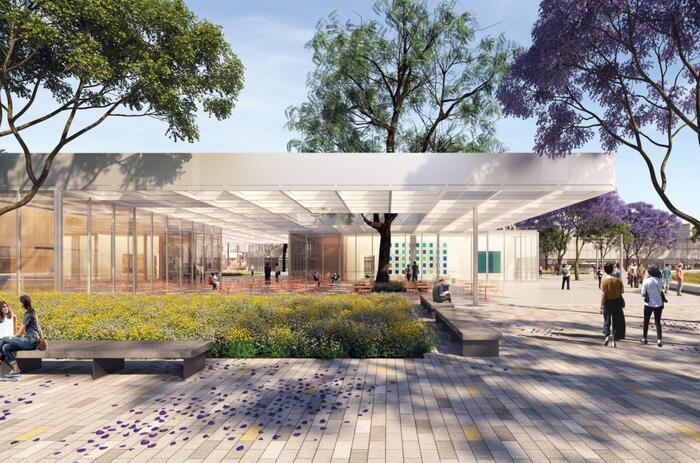
The Malba museum in Buenos Aires, Argentina expands with the construction of Malba Puertos, a new exhibition space in Escobar, province of Buenos Aires. It opens on September 21 and seeks -through activities and exhibitions- to bring art closer to the community.
MALBA PUERTOS: THE NEW VENUE IN ESCOBAR TO OPEN IN SEPTEMBER
The Malba museum in Buenos Aires, Argentina expands with the construction of Malba Puertos, a new exhibition space in Escobar, province of Buenos Aires. It opens on September 21 and seeks -through activities and exhibitions- to bring art closer to the community.

The Malba museum in Buenos Aires, Argentina expands with the construction of Malba Puertos, a new exhibition space in Escobar, province of Buenos Aires. It opens on September 21 and seeks -through activities and exhibitions- to bring art closer to the community.
MALBA PUERTOS: THE NEW VENUE IN ESCOBAR TO OPEN IN SEPTEMBER
The Malba museum in Buenos Aires, Argentina expands with the construction of Malba Puertos, a new exhibition space in Escobar, province of Buenos Aires. It opens on September 21 and seeks -through activities and exhibitions- to bring art closer to the community.
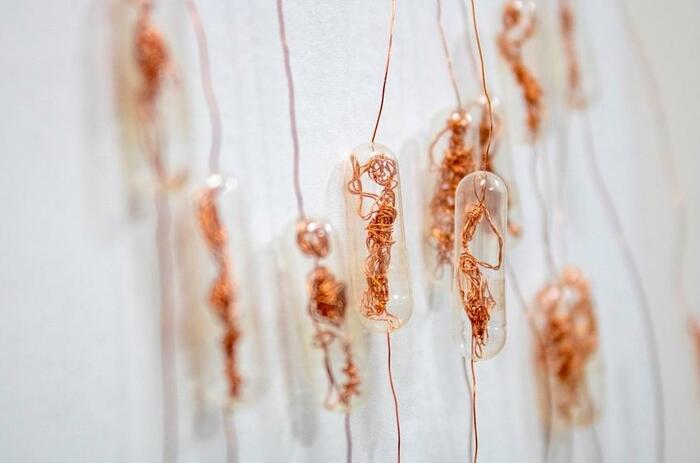
The Patio Herreriano Museum hosts the recent proposal by Sandra Gamboa (Bogota, Colombia) in which she outlines the necessary arguments to be able to analyse mental health, especially anxiety and depression. In Encapsulados, the Colombian-Spanish artist invites us to carry out this exercise of understanding, rapprochement and empathy with those who suffer from one of the great plagues of this century through the different related iconography that fills the exhibition hall of the Castilian institution.
ENCAPSULADOS, BY SANDRA GAMBOA, IN VALLADOLID
The Patio Herreriano Museum hosts the recent proposal by Sandra Gamboa (Bogota, Colombia) in which she outlines the necessary arguments to be able to analyse mental health, especially anxiety and depression. In Encapsulados, the Colombian-Spanish artist invites us to carry out this exercise of understanding, rapprochement and empathy with those who suffer from one of the great plagues of this century through the different related iconography that fills the exhibition hall of the Castilian institution.
It takes an Island to Feel this Good is Darja Bajagić’s exhibition for the Montenegro pavilion at Venice Biennale 2024. Curated by Ana Simona Zelenović and organized by the Museum of Contemporary Art of Montenegro at the initiative of commissioner Vladislav Šćepanović, the exhibition will present a critical consideration of the culture of collective memory and the relationship to shared historical heritage.
ICONOGRAPHY, MEMORY AND HISTORY - THE MONTENEGRO PAVILION
It takes an Island to Feel this Good is Darja Bajagić’s exhibition for the Montenegro pavilion at Venice Biennale 2024. Curated by Ana Simona Zelenović and organized by the Museum of Contemporary Art of Montenegro at the initiative of commissioner Vladislav Šćepanović, the exhibition will present a critical consideration of the culture of collective memory and the relationship to shared historical heritage.
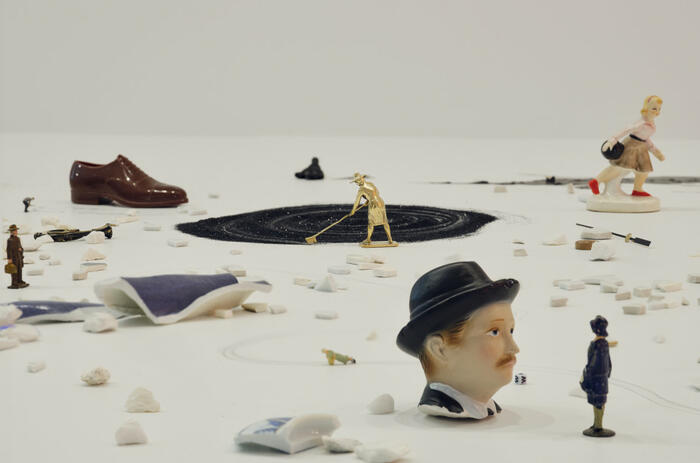
Liliana Porter: The Task is the artist’s exhibition at Dia Bridgehampton. The exhibition comprises a new commission alongside a selection of works from the 1970s and video documentation of a recent play by Porter and collaborator Ana Tiscornia.
LILIANA PORTER'S DISLOCATED TIME
Liliana Porter: The Task is the artist’s exhibition at Dia Bridgehampton. The exhibition comprises a new commission alongside a selection of works from the 1970s and video documentation of a recent play by Porter and collaborator Ana Tiscornia.
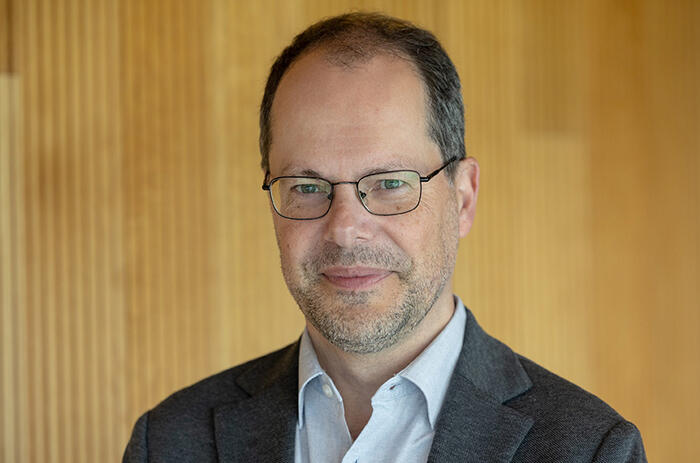
After six years of his collaboration as a teacher in the Master's Degree in Curatorial Studies offered by the Museo Universidad de Navarra (MUN), Gabriel Pérez-Barreriro has been appointed as the institution's new artistic director. With extensive experience in university museums and other centers in Europe, the United States and Latin America, he is now the new head of the MUN's artistic strategy together with Teresa Lasheras, artistic director of performing arts and music.
GABRIEL PÉREZ-BARREIRO: THE MUN'S NEW ARTISTIC DIRECTOR
After six years of his collaboration as a teacher in the Master's Degree in Curatorial Studies offered by the Museo Universidad de Navarra (MUN), Gabriel Pérez-Barreriro has been appointed as the institution's new artistic director. With extensive experience in university museums and other centers in Europe, the United States and Latin America, he is now the new head of the MUN's artistic strategy together with Teresa Lasheras, artistic director of performing arts and music.
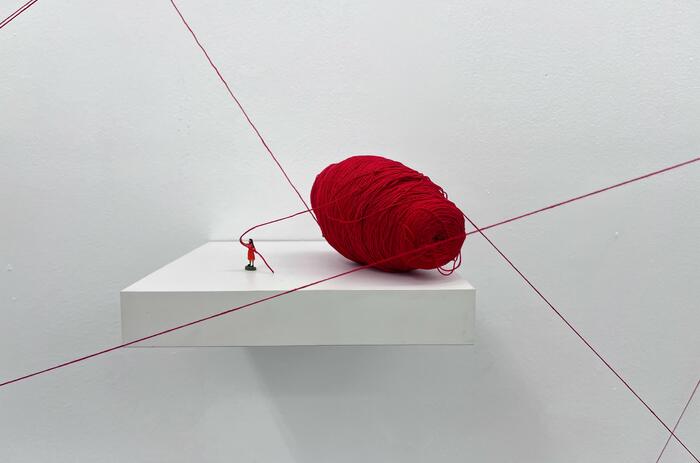
Liliana Porter (Buenos Aires, Argentina, 1941) has a long history shared with Espacio Minimo. The Madrid gallery pampers every move and celebrates the extensive relationship with the Argentinean artist, always offering her the possibility of receiving her work and witnessing its evolution. For the opening of the space's season, the landing is called Otros cuentos inconclusos, a new proposal that deals with representation and two dimensional axes —space and time— that bear witness to many of the questions raised about human relations.
THE UNFINISHED STORIES OF LILIANA PORTER
Liliana Porter (Buenos Aires, Argentina, 1941) has a long history shared with Espacio Minimo. The Madrid gallery pampers every move and celebrates the extensive relationship with the Argentinean artist, always offering her the possibility of receiving her work and witnessing its evolution. For the opening of the space's season, the landing is called Otros cuentos inconclusos, a new proposal that deals with representation and two dimensional axes —space and time— that bear witness to many of the questions raised about human relations.
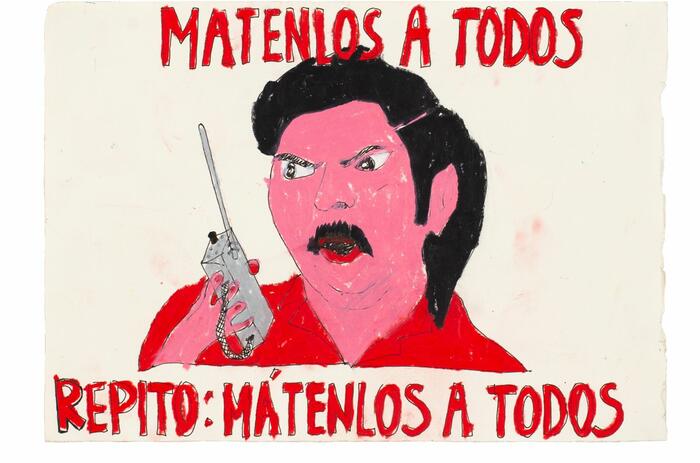
The double problem that arose from the acquisition in the 1980s of several hippopotamuses in one of the many eccentricities of the trafficker Pablo Escóbar is the starting point of a fable that, between the tragic and the comic, Camilo Restrepo (Medellín, Colombia, 1975) has managed to weave with a very successful graphic and conceptual narrative. With Cocaine Hippos Sweat Blood, the spectator faces this surrealistic story from its beginnings to the present by the hand of a figurativism that sets aside the academic and the technical for the sake of a greater aesthetic and relational concordance with that of the madness transmitted by the story itself.
THE NARCO-HYPOPOTAMUSES’ TALE, BY CAMILO RESTREPO
The double problem that arose from the acquisition in the 1980s of several hippopotamuses in one of the many eccentricities of the trafficker Pablo Escóbar is the starting point of a fable that, between the tragic and the comic, Camilo Restrepo (Medellín, Colombia, 1975) has managed to weave with a very successful graphic and conceptual narrative. With Cocaine Hippos Sweat Blood, the spectator faces this surrealistic story from its beginnings to the present by the hand of a figurativism that sets aside the academic and the technical for the sake of a greater aesthetic and relational concordance with that of the madness transmitted by the story itself.
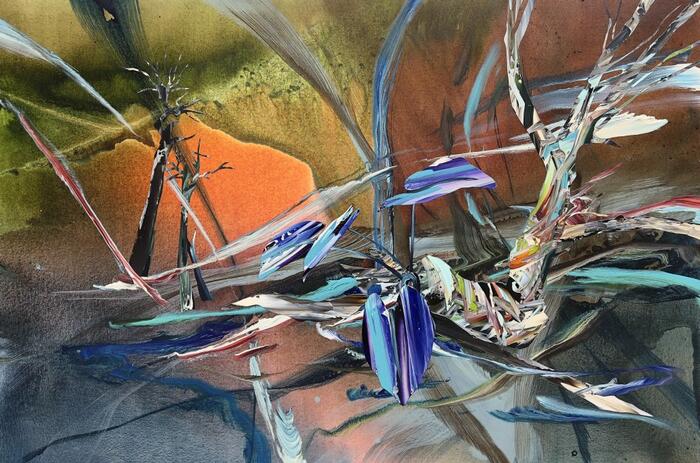
Germán Tagle (Santiago, Chile, 1976) returns to Madrid's Daniel Cuevas, where he held his first exhibition two years ago, with El territorio portátil, a show in which the Chilean artist returns to the axes of landscape, painting and culture that have been the backbone of his latest productions.
GERMÁN TAGLE'S REDEFINITION OF LANDSCAPE
Germán Tagle (Santiago, Chile, 1976) returns to Madrid's Daniel Cuevas, where he held his first exhibition two years ago, with El territorio portátil, a show in which the Chilean artist returns to the axes of landscape, painting and culture that have been the backbone of his latest productions.
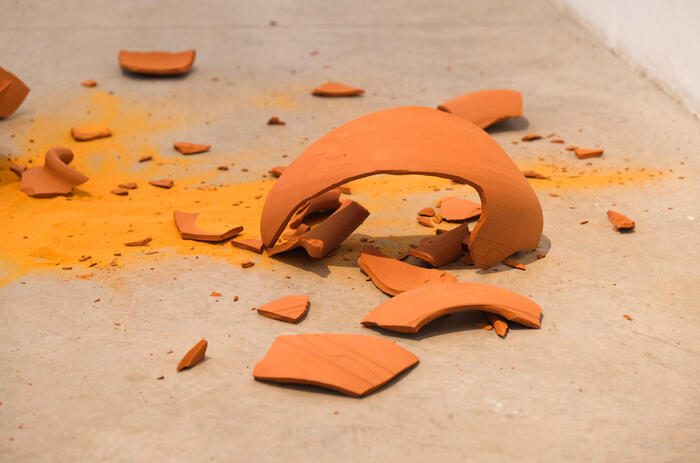
Héctor Zamora (Mexico City, Mexico, 1974) navigates between opposing concepts. His particular interest in the incessant search, or in the eagerness of understanding, for conceptual equilibrium serves as an engine for a creative explosion in the search for that fragile space that results between actions and intentions, between should and being. In Emergencia, his first solo exhibition at Madrid's Albarrán Bourdais, the Mexican artist manages to capture in several dimensions that almost obsessive vocation of his personal struggle between the opposite poles that have been shaping his proposal.
HARMONY AND CHANCE IN HÉCTOR ZAMORA'S EMERGENCIA
Héctor Zamora (Mexico City, Mexico, 1974) navigates between opposing concepts. His particular interest in the incessant search, or in the eagerness of understanding, for conceptual equilibrium serves as an engine for a creative explosion in the search for that fragile space that results between actions and intentions, between should and being. In Emergencia, his first solo exhibition at Madrid's Albarrán Bourdais, the Mexican artist manages to capture in several dimensions that almost obsessive vocation of his personal struggle between the opposite poles that have been shaping his proposal.
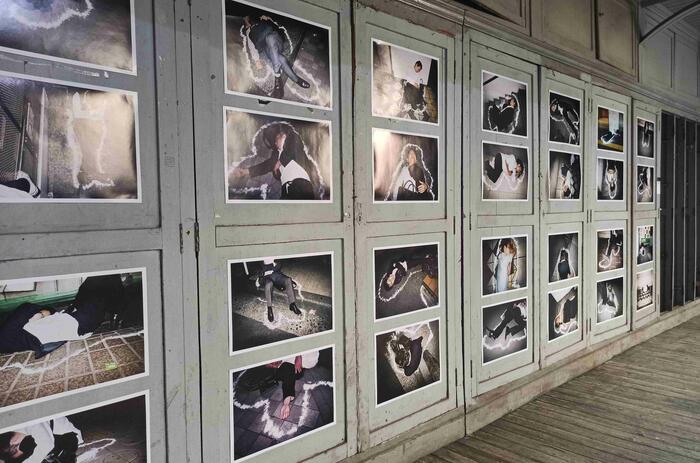
There seems to be, and increasingly so, a constant and growing debate in the social sphere about labor relations and the impact of work on people. Almost absolute concepts in current narratives such as work-life balance or resilience lack the necessary background to create that conversation. However, in order to build precisely on them, the research being done on the impact and culture of work in this new revision that Postmodernity leads to value proposals such as the one Allegra Pacheco (San Jose, Costa Rica, 1986) lands in her conceptual Dear Salaryman, which in its latest evolution is exhibited at the Museo La Neomudéjar in Madrid.
ALLEGRA PACHECO AND THE IMPACT OF THE LABOR ISSUE
There seems to be, and increasingly so, a constant and growing debate in the social sphere about labor relations and the impact of work on people. Almost absolute concepts in current narratives such as work-life balance or resilience lack the necessary background to create that conversation. However, in order to build precisely on them, the research being done on the impact and culture of work in this new revision that Postmodernity leads to value proposals such as the one Allegra Pacheco (San Jose, Costa Rica, 1986) lands in her conceptual Dear Salaryman, which in its latest evolution is exhibited at the Museo La Neomudéjar in Madrid.
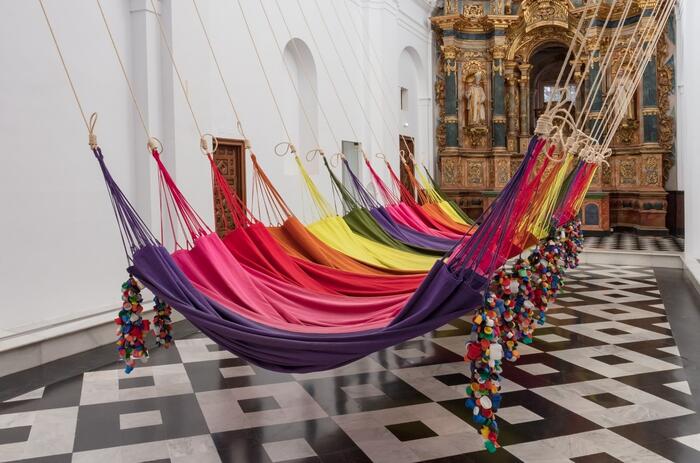
The artistic collective from Rio de Janeiro OPAVIVARÁ! intervenes in the space of the Capilla de Afuera of the Centro Andaluz de Arte Contemporáneo in Seville with its Rede social, a sensorial and materialized symbology with which the Brazilians invite the spectator to place himself in a position to negotiate and cooperate with his fellow men and women. The intervention, consisting of the unfolding of fabric hammocks that acquire the rhythm and cadence that the visitor imprints with his movement and presence and that adds sounds of snoring, follows the group's premise of building spaces and devices that offer a collaborative experience.
OPAVIVARÁ! INSTALLS ITS “SOCIAL NETWORK” IN THE CAAC
The artistic collective from Rio de Janeiro OPAVIVARÁ! intervenes in the space of the Capilla de Afuera of the Centro Andaluz de Arte Contemporáneo in Seville with its Rede social, a sensorial and materialized symbology with which the Brazilians invite the spectator to place himself in a position to negotiate and cooperate with his fellow men and women. The intervention, consisting of the unfolding of fabric hammocks that acquire the rhythm and cadence that the visitor imprints with his movement and presence and that adds sounds of snoring, follows the group's premise of building spaces and devices that offer a collaborative experience.
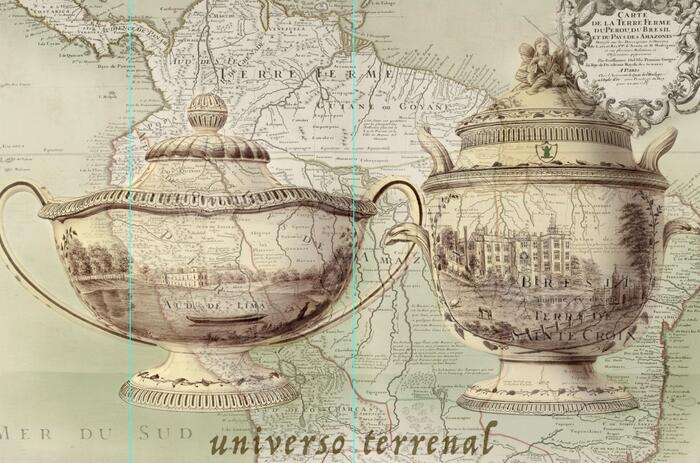
From her different interdisciplinary perspectives, Cecilia Paredes (Lima, Peru, 1950) lands in Blanca Berlin with a collection of images that deal with imaginary cartographies, displacements and human relations in their conceptual part, materialized, above all, on canvas as the main exhibition material. In Historias errantes (Wandering Stories), the Peruvian artist bets on recovering graphic materials anchored in antiquity, such as astrological charts, engravings of discoveries and maps, which become, after the manipulation of the parts, absolute compositions of impossible -but also aesthetic- iconography.
THE WANDERING STORIES OF CECILIA PAREDES, IN BLANCA BERLIN
From her different interdisciplinary perspectives, Cecilia Paredes (Lima, Peru, 1950) lands in Blanca Berlin with a collection of images that deal with imaginary cartographies, displacements and human relations in their conceptual part, materialized, above all, on canvas as the main exhibition material. In Historias errantes (Wandering Stories), the Peruvian artist bets on recovering graphic materials anchored in antiquity, such as astrological charts, engravings of discoveries and maps, which become, after the manipulation of the parts, absolute compositions of impossible -but also aesthetic- iconography.

The Malba museum in Buenos Aires, Argentina expands with the construction of Malba Puertos, a new exhibition space in Escobar, province of Buenos Aires. It opens on September 21 and seeks -through activities and exhibitions- to bring art closer to the community.
MALBA PUERTOS: THE NEW VENUE IN ESCOBAR TO OPEN IN SEPTEMBER
The Malba museum in Buenos Aires, Argentina expands with the construction of Malba Puertos, a new exhibition space in Escobar, province of Buenos Aires. It opens on September 21 and seeks -through activities and exhibitions- to bring art closer to the community.

The Patio Herreriano Museum hosts the recent proposal by Sandra Gamboa (Bogota, Colombia) in which she outlines the necessary arguments to be able to analyse mental health, especially anxiety and depression. In Encapsulados, the Colombian-Spanish artist invites us to carry out this exercise of understanding, rapprochement and empathy with those who suffer from one of the great plagues of this century through the different related iconography that fills the exhibition hall of the Castilian institution.
ENCAPSULADOS, BY SANDRA GAMBOA, IN VALLADOLID
The Patio Herreriano Museum hosts the recent proposal by Sandra Gamboa (Bogota, Colombia) in which she outlines the necessary arguments to be able to analyse mental health, especially anxiety and depression. In Encapsulados, the Colombian-Spanish artist invites us to carry out this exercise of understanding, rapprochement and empathy with those who suffer from one of the great plagues of this century through the different related iconography that fills the exhibition hall of the Castilian institution.
It takes an Island to Feel this Good is Darja Bajagić’s exhibition for the Montenegro pavilion at Venice Biennale 2024. Curated by Ana Simona Zelenović and organized by the Museum of Contemporary Art of Montenegro at the initiative of commissioner Vladislav Šćepanović, the exhibition will present a critical consideration of the culture of collective memory and the relationship to shared historical heritage.
ICONOGRAPHY, MEMORY AND HISTORY - THE MONTENEGRO PAVILION
It takes an Island to Feel this Good is Darja Bajagić’s exhibition for the Montenegro pavilion at Venice Biennale 2024. Curated by Ana Simona Zelenović and organized by the Museum of Contemporary Art of Montenegro at the initiative of commissioner Vladislav Šćepanović, the exhibition will present a critical consideration of the culture of collective memory and the relationship to shared historical heritage.

Liliana Porter: The Task is the artist’s exhibition at Dia Bridgehampton. The exhibition comprises a new commission alongside a selection of works from the 1970s and video documentation of a recent play by Porter and collaborator Ana Tiscornia.
LILIANA PORTER'S DISLOCATED TIME
Liliana Porter: The Task is the artist’s exhibition at Dia Bridgehampton. The exhibition comprises a new commission alongside a selection of works from the 1970s and video documentation of a recent play by Porter and collaborator Ana Tiscornia.

After six years of his collaboration as a teacher in the Master's Degree in Curatorial Studies offered by the Museo Universidad de Navarra (MUN), Gabriel Pérez-Barreriro has been appointed as the institution's new artistic director. With extensive experience in university museums and other centers in Europe, the United States and Latin America, he is now the new head of the MUN's artistic strategy together with Teresa Lasheras, artistic director of performing arts and music.
GABRIEL PÉREZ-BARREIRO: THE MUN'S NEW ARTISTIC DIRECTOR
After six years of his collaboration as a teacher in the Master's Degree in Curatorial Studies offered by the Museo Universidad de Navarra (MUN), Gabriel Pérez-Barreriro has been appointed as the institution's new artistic director. With extensive experience in university museums and other centers in Europe, the United States and Latin America, he is now the new head of the MUN's artistic strategy together with Teresa Lasheras, artistic director of performing arts and music.

Liliana Porter (Buenos Aires, Argentina, 1941) has a long history shared with Espacio Minimo. The Madrid gallery pampers every move and celebrates the extensive relationship with the Argentinean artist, always offering her the possibility of receiving her work and witnessing its evolution. For the opening of the space's season, the landing is called Otros cuentos inconclusos, a new proposal that deals with representation and two dimensional axes —space and time— that bear witness to many of the questions raised about human relations.
THE UNFINISHED STORIES OF LILIANA PORTER
Liliana Porter (Buenos Aires, Argentina, 1941) has a long history shared with Espacio Minimo. The Madrid gallery pampers every move and celebrates the extensive relationship with the Argentinean artist, always offering her the possibility of receiving her work and witnessing its evolution. For the opening of the space's season, the landing is called Otros cuentos inconclusos, a new proposal that deals with representation and two dimensional axes —space and time— that bear witness to many of the questions raised about human relations.

The double problem that arose from the acquisition in the 1980s of several hippopotamuses in one of the many eccentricities of the trafficker Pablo Escóbar is the starting point of a fable that, between the tragic and the comic, Camilo Restrepo (Medellín, Colombia, 1975) has managed to weave with a very successful graphic and conceptual narrative. With Cocaine Hippos Sweat Blood, the spectator faces this surrealistic story from its beginnings to the present by the hand of a figurativism that sets aside the academic and the technical for the sake of a greater aesthetic and relational concordance with that of the madness transmitted by the story itself.
THE NARCO-HYPOPOTAMUSES’ TALE, BY CAMILO RESTREPO
The double problem that arose from the acquisition in the 1980s of several hippopotamuses in one of the many eccentricities of the trafficker Pablo Escóbar is the starting point of a fable that, between the tragic and the comic, Camilo Restrepo (Medellín, Colombia, 1975) has managed to weave with a very successful graphic and conceptual narrative. With Cocaine Hippos Sweat Blood, the spectator faces this surrealistic story from its beginnings to the present by the hand of a figurativism that sets aside the academic and the technical for the sake of a greater aesthetic and relational concordance with that of the madness transmitted by the story itself.

Germán Tagle (Santiago, Chile, 1976) returns to Madrid's Daniel Cuevas, where he held his first exhibition two years ago, with El territorio portátil, a show in which the Chilean artist returns to the axes of landscape, painting and culture that have been the backbone of his latest productions.
GERMÁN TAGLE'S REDEFINITION OF LANDSCAPE
Germán Tagle (Santiago, Chile, 1976) returns to Madrid's Daniel Cuevas, where he held his first exhibition two years ago, with El territorio portátil, a show in which the Chilean artist returns to the axes of landscape, painting and culture that have been the backbone of his latest productions.

Héctor Zamora (Mexico City, Mexico, 1974) navigates between opposing concepts. His particular interest in the incessant search, or in the eagerness of understanding, for conceptual equilibrium serves as an engine for a creative explosion in the search for that fragile space that results between actions and intentions, between should and being. In Emergencia, his first solo exhibition at Madrid's Albarrán Bourdais, the Mexican artist manages to capture in several dimensions that almost obsessive vocation of his personal struggle between the opposite poles that have been shaping his proposal.
HARMONY AND CHANCE IN HÉCTOR ZAMORA'S EMERGENCIA
Héctor Zamora (Mexico City, Mexico, 1974) navigates between opposing concepts. His particular interest in the incessant search, or in the eagerness of understanding, for conceptual equilibrium serves as an engine for a creative explosion in the search for that fragile space that results between actions and intentions, between should and being. In Emergencia, his first solo exhibition at Madrid's Albarrán Bourdais, the Mexican artist manages to capture in several dimensions that almost obsessive vocation of his personal struggle between the opposite poles that have been shaping his proposal.

There seems to be, and increasingly so, a constant and growing debate in the social sphere about labor relations and the impact of work on people. Almost absolute concepts in current narratives such as work-life balance or resilience lack the necessary background to create that conversation. However, in order to build precisely on them, the research being done on the impact and culture of work in this new revision that Postmodernity leads to value proposals such as the one Allegra Pacheco (San Jose, Costa Rica, 1986) lands in her conceptual Dear Salaryman, which in its latest evolution is exhibited at the Museo La Neomudéjar in Madrid.
ALLEGRA PACHECO AND THE IMPACT OF THE LABOR ISSUE
There seems to be, and increasingly so, a constant and growing debate in the social sphere about labor relations and the impact of work on people. Almost absolute concepts in current narratives such as work-life balance or resilience lack the necessary background to create that conversation. However, in order to build precisely on them, the research being done on the impact and culture of work in this new revision that Postmodernity leads to value proposals such as the one Allegra Pacheco (San Jose, Costa Rica, 1986) lands in her conceptual Dear Salaryman, which in its latest evolution is exhibited at the Museo La Neomudéjar in Madrid.

The artistic collective from Rio de Janeiro OPAVIVARÁ! intervenes in the space of the Capilla de Afuera of the Centro Andaluz de Arte Contemporáneo in Seville with its Rede social, a sensorial and materialized symbology with which the Brazilians invite the spectator to place himself in a position to negotiate and cooperate with his fellow men and women. The intervention, consisting of the unfolding of fabric hammocks that acquire the rhythm and cadence that the visitor imprints with his movement and presence and that adds sounds of snoring, follows the group's premise of building spaces and devices that offer a collaborative experience.
OPAVIVARÁ! INSTALLS ITS “SOCIAL NETWORK” IN THE CAAC
The artistic collective from Rio de Janeiro OPAVIVARÁ! intervenes in the space of the Capilla de Afuera of the Centro Andaluz de Arte Contemporáneo in Seville with its Rede social, a sensorial and materialized symbology with which the Brazilians invite the spectator to place himself in a position to negotiate and cooperate with his fellow men and women. The intervention, consisting of the unfolding of fabric hammocks that acquire the rhythm and cadence that the visitor imprints with his movement and presence and that adds sounds of snoring, follows the group's premise of building spaces and devices that offer a collaborative experience.

From her different interdisciplinary perspectives, Cecilia Paredes (Lima, Peru, 1950) lands in Blanca Berlin with a collection of images that deal with imaginary cartographies, displacements and human relations in their conceptual part, materialized, above all, on canvas as the main exhibition material. In Historias errantes (Wandering Stories), the Peruvian artist bets on recovering graphic materials anchored in antiquity, such as astrological charts, engravings of discoveries and maps, which become, after the manipulation of the parts, absolute compositions of impossible -but also aesthetic- iconography.
THE WANDERING STORIES OF CECILIA PAREDES, IN BLANCA BERLIN
From her different interdisciplinary perspectives, Cecilia Paredes (Lima, Peru, 1950) lands in Blanca Berlin with a collection of images that deal with imaginary cartographies, displacements and human relations in their conceptual part, materialized, above all, on canvas as the main exhibition material. In Historias errantes (Wandering Stories), the Peruvian artist bets on recovering graphic materials anchored in antiquity, such as astrological charts, engravings of discoveries and maps, which become, after the manipulation of the parts, absolute compositions of impossible -but also aesthetic- iconography.

The Malba museum in Buenos Aires, Argentina expands with the construction of Malba Puertos, a new exhibition space in Escobar, province of Buenos Aires. It opens on September 21 and seeks -through activities and exhibitions- to bring art closer to the community.
MALBA PUERTOS: THE NEW VENUE IN ESCOBAR TO OPEN IN SEPTEMBER
The Malba museum in Buenos Aires, Argentina expands with the construction of Malba Puertos, a new exhibition space in Escobar, province of Buenos Aires. It opens on September 21 and seeks -through activities and exhibitions- to bring art closer to the community.

The Patio Herreriano Museum hosts the recent proposal by Sandra Gamboa (Bogota, Colombia) in which she outlines the necessary arguments to be able to analyse mental health, especially anxiety and depression. In Encapsulados, the Colombian-Spanish artist invites us to carry out this exercise of understanding, rapprochement and empathy with those who suffer from one of the great plagues of this century through the different related iconography that fills the exhibition hall of the Castilian institution.
ENCAPSULADOS, BY SANDRA GAMBOA, IN VALLADOLID
The Patio Herreriano Museum hosts the recent proposal by Sandra Gamboa (Bogota, Colombia) in which she outlines the necessary arguments to be able to analyse mental health, especially anxiety and depression. In Encapsulados, the Colombian-Spanish artist invites us to carry out this exercise of understanding, rapprochement and empathy with those who suffer from one of the great plagues of this century through the different related iconography that fills the exhibition hall of the Castilian institution.
It takes an Island to Feel this Good is Darja Bajagić’s exhibition for the Montenegro pavilion at Venice Biennale 2024. Curated by Ana Simona Zelenović and organized by the Museum of Contemporary Art of Montenegro at the initiative of commissioner Vladislav Šćepanović, the exhibition will present a critical consideration of the culture of collective memory and the relationship to shared historical heritage.
ICONOGRAPHY, MEMORY AND HISTORY - THE MONTENEGRO PAVILION
It takes an Island to Feel this Good is Darja Bajagić’s exhibition for the Montenegro pavilion at Venice Biennale 2024. Curated by Ana Simona Zelenović and organized by the Museum of Contemporary Art of Montenegro at the initiative of commissioner Vladislav Šćepanović, the exhibition will present a critical consideration of the culture of collective memory and the relationship to shared historical heritage.

Liliana Porter: The Task is the artist’s exhibition at Dia Bridgehampton. The exhibition comprises a new commission alongside a selection of works from the 1970s and video documentation of a recent play by Porter and collaborator Ana Tiscornia.
LILIANA PORTER'S DISLOCATED TIME
Liliana Porter: The Task is the artist’s exhibition at Dia Bridgehampton. The exhibition comprises a new commission alongside a selection of works from the 1970s and video documentation of a recent play by Porter and collaborator Ana Tiscornia.

After six years of his collaboration as a teacher in the Master's Degree in Curatorial Studies offered by the Museo Universidad de Navarra (MUN), Gabriel Pérez-Barreriro has been appointed as the institution's new artistic director. With extensive experience in university museums and other centers in Europe, the United States and Latin America, he is now the new head of the MUN's artistic strategy together with Teresa Lasheras, artistic director of performing arts and music.
GABRIEL PÉREZ-BARREIRO: THE MUN'S NEW ARTISTIC DIRECTOR
After six years of his collaboration as a teacher in the Master's Degree in Curatorial Studies offered by the Museo Universidad de Navarra (MUN), Gabriel Pérez-Barreriro has been appointed as the institution's new artistic director. With extensive experience in university museums and other centers in Europe, the United States and Latin America, he is now the new head of the MUN's artistic strategy together with Teresa Lasheras, artistic director of performing arts and music.

Liliana Porter (Buenos Aires, Argentina, 1941) has a long history shared with Espacio Minimo. The Madrid gallery pampers every move and celebrates the extensive relationship with the Argentinean artist, always offering her the possibility of receiving her work and witnessing its evolution. For the opening of the space's season, the landing is called Otros cuentos inconclusos, a new proposal that deals with representation and two dimensional axes —space and time— that bear witness to many of the questions raised about human relations.
THE UNFINISHED STORIES OF LILIANA PORTER
Liliana Porter (Buenos Aires, Argentina, 1941) has a long history shared with Espacio Minimo. The Madrid gallery pampers every move and celebrates the extensive relationship with the Argentinean artist, always offering her the possibility of receiving her work and witnessing its evolution. For the opening of the space's season, the landing is called Otros cuentos inconclusos, a new proposal that deals with representation and two dimensional axes —space and time— that bear witness to many of the questions raised about human relations.

The double problem that arose from the acquisition in the 1980s of several hippopotamuses in one of the many eccentricities of the trafficker Pablo Escóbar is the starting point of a fable that, between the tragic and the comic, Camilo Restrepo (Medellín, Colombia, 1975) has managed to weave with a very successful graphic and conceptual narrative. With Cocaine Hippos Sweat Blood, the spectator faces this surrealistic story from its beginnings to the present by the hand of a figurativism that sets aside the academic and the technical for the sake of a greater aesthetic and relational concordance with that of the madness transmitted by the story itself.
THE NARCO-HYPOPOTAMUSES’ TALE, BY CAMILO RESTREPO
The double problem that arose from the acquisition in the 1980s of several hippopotamuses in one of the many eccentricities of the trafficker Pablo Escóbar is the starting point of a fable that, between the tragic and the comic, Camilo Restrepo (Medellín, Colombia, 1975) has managed to weave with a very successful graphic and conceptual narrative. With Cocaine Hippos Sweat Blood, the spectator faces this surrealistic story from its beginnings to the present by the hand of a figurativism that sets aside the academic and the technical for the sake of a greater aesthetic and relational concordance with that of the madness transmitted by the story itself.

Germán Tagle (Santiago, Chile, 1976) returns to Madrid's Daniel Cuevas, where he held his first exhibition two years ago, with El territorio portátil, a show in which the Chilean artist returns to the axes of landscape, painting and culture that have been the backbone of his latest productions.
GERMÁN TAGLE'S REDEFINITION OF LANDSCAPE
Germán Tagle (Santiago, Chile, 1976) returns to Madrid's Daniel Cuevas, where he held his first exhibition two years ago, with El territorio portátil, a show in which the Chilean artist returns to the axes of landscape, painting and culture that have been the backbone of his latest productions.

Héctor Zamora (Mexico City, Mexico, 1974) navigates between opposing concepts. His particular interest in the incessant search, or in the eagerness of understanding, for conceptual equilibrium serves as an engine for a creative explosion in the search for that fragile space that results between actions and intentions, between should and being. In Emergencia, his first solo exhibition at Madrid's Albarrán Bourdais, the Mexican artist manages to capture in several dimensions that almost obsessive vocation of his personal struggle between the opposite poles that have been shaping his proposal.
HARMONY AND CHANCE IN HÉCTOR ZAMORA'S EMERGENCIA
Héctor Zamora (Mexico City, Mexico, 1974) navigates between opposing concepts. His particular interest in the incessant search, or in the eagerness of understanding, for conceptual equilibrium serves as an engine for a creative explosion in the search for that fragile space that results between actions and intentions, between should and being. In Emergencia, his first solo exhibition at Madrid's Albarrán Bourdais, the Mexican artist manages to capture in several dimensions that almost obsessive vocation of his personal struggle between the opposite poles that have been shaping his proposal.

There seems to be, and increasingly so, a constant and growing debate in the social sphere about labor relations and the impact of work on people. Almost absolute concepts in current narratives such as work-life balance or resilience lack the necessary background to create that conversation. However, in order to build precisely on them, the research being done on the impact and culture of work in this new revision that Postmodernity leads to value proposals such as the one Allegra Pacheco (San Jose, Costa Rica, 1986) lands in her conceptual Dear Salaryman, which in its latest evolution is exhibited at the Museo La Neomudéjar in Madrid.
ALLEGRA PACHECO AND THE IMPACT OF THE LABOR ISSUE
There seems to be, and increasingly so, a constant and growing debate in the social sphere about labor relations and the impact of work on people. Almost absolute concepts in current narratives such as work-life balance or resilience lack the necessary background to create that conversation. However, in order to build precisely on them, the research being done on the impact and culture of work in this new revision that Postmodernity leads to value proposals such as the one Allegra Pacheco (San Jose, Costa Rica, 1986) lands in her conceptual Dear Salaryman, which in its latest evolution is exhibited at the Museo La Neomudéjar in Madrid.

The artistic collective from Rio de Janeiro OPAVIVARÁ! intervenes in the space of the Capilla de Afuera of the Centro Andaluz de Arte Contemporáneo in Seville with its Rede social, a sensorial and materialized symbology with which the Brazilians invite the spectator to place himself in a position to negotiate and cooperate with his fellow men and women. The intervention, consisting of the unfolding of fabric hammocks that acquire the rhythm and cadence that the visitor imprints with his movement and presence and that adds sounds of snoring, follows the group's premise of building spaces and devices that offer a collaborative experience.
OPAVIVARÁ! INSTALLS ITS “SOCIAL NETWORK” IN THE CAAC
The artistic collective from Rio de Janeiro OPAVIVARÁ! intervenes in the space of the Capilla de Afuera of the Centro Andaluz de Arte Contemporáneo in Seville with its Rede social, a sensorial and materialized symbology with which the Brazilians invite the spectator to place himself in a position to negotiate and cooperate with his fellow men and women. The intervention, consisting of the unfolding of fabric hammocks that acquire the rhythm and cadence that the visitor imprints with his movement and presence and that adds sounds of snoring, follows the group's premise of building spaces and devices that offer a collaborative experience.

From her different interdisciplinary perspectives, Cecilia Paredes (Lima, Peru, 1950) lands in Blanca Berlin with a collection of images that deal with imaginary cartographies, displacements and human relations in their conceptual part, materialized, above all, on canvas as the main exhibition material. In Historias errantes (Wandering Stories), the Peruvian artist bets on recovering graphic materials anchored in antiquity, such as astrological charts, engravings of discoveries and maps, which become, after the manipulation of the parts, absolute compositions of impossible -but also aesthetic- iconography.
THE WANDERING STORIES OF CECILIA PAREDES, IN BLANCA BERLIN
From her different interdisciplinary perspectives, Cecilia Paredes (Lima, Peru, 1950) lands in Blanca Berlin with a collection of images that deal with imaginary cartographies, displacements and human relations in their conceptual part, materialized, above all, on canvas as the main exhibition material. In Historias errantes (Wandering Stories), the Peruvian artist bets on recovering graphic materials anchored in antiquity, such as astrological charts, engravings of discoveries and maps, which become, after the manipulation of the parts, absolute compositions of impossible -but also aesthetic- iconography.

The Malba museum in Buenos Aires, Argentina expands with the construction of Malba Puertos, a new exhibition space in Escobar, province of Buenos Aires. It opens on September 21 and seeks -through activities and exhibitions- to bring art closer to the community.
MALBA PUERTOS: THE NEW VENUE IN ESCOBAR TO OPEN IN SEPTEMBER
The Malba museum in Buenos Aires, Argentina expands with the construction of Malba Puertos, a new exhibition space in Escobar, province of Buenos Aires. It opens on September 21 and seeks -through activities and exhibitions- to bring art closer to the community.

The Patio Herreriano Museum hosts the recent proposal by Sandra Gamboa (Bogota, Colombia) in which she outlines the necessary arguments to be able to analyse mental health, especially anxiety and depression. In Encapsulados, the Colombian-Spanish artist invites us to carry out this exercise of understanding, rapprochement and empathy with those who suffer from one of the great plagues of this century through the different related iconography that fills the exhibition hall of the Castilian institution.
ENCAPSULADOS, BY SANDRA GAMBOA, IN VALLADOLID
The Patio Herreriano Museum hosts the recent proposal by Sandra Gamboa (Bogota, Colombia) in which she outlines the necessary arguments to be able to analyse mental health, especially anxiety and depression. In Encapsulados, the Colombian-Spanish artist invites us to carry out this exercise of understanding, rapprochement and empathy with those who suffer from one of the great plagues of this century through the different related iconography that fills the exhibition hall of the Castilian institution.
It takes an Island to Feel this Good is Darja Bajagić’s exhibition for the Montenegro pavilion at Venice Biennale 2024. Curated by Ana Simona Zelenović and organized by the Museum of Contemporary Art of Montenegro at the initiative of commissioner Vladislav Šćepanović, the exhibition will present a critical consideration of the culture of collective memory and the relationship to shared historical heritage.
ICONOGRAPHY, MEMORY AND HISTORY - THE MONTENEGRO PAVILION
It takes an Island to Feel this Good is Darja Bajagić’s exhibition for the Montenegro pavilion at Venice Biennale 2024. Curated by Ana Simona Zelenović and organized by the Museum of Contemporary Art of Montenegro at the initiative of commissioner Vladislav Šćepanović, the exhibition will present a critical consideration of the culture of collective memory and the relationship to shared historical heritage.

Liliana Porter: The Task is the artist’s exhibition at Dia Bridgehampton. The exhibition comprises a new commission alongside a selection of works from the 1970s and video documentation of a recent play by Porter and collaborator Ana Tiscornia.
LILIANA PORTER'S DISLOCATED TIME
Liliana Porter: The Task is the artist’s exhibition at Dia Bridgehampton. The exhibition comprises a new commission alongside a selection of works from the 1970s and video documentation of a recent play by Porter and collaborator Ana Tiscornia.

After six years of his collaboration as a teacher in the Master's Degree in Curatorial Studies offered by the Museo Universidad de Navarra (MUN), Gabriel Pérez-Barreriro has been appointed as the institution's new artistic director. With extensive experience in university museums and other centers in Europe, the United States and Latin America, he is now the new head of the MUN's artistic strategy together with Teresa Lasheras, artistic director of performing arts and music.
GABRIEL PÉREZ-BARREIRO: THE MUN'S NEW ARTISTIC DIRECTOR
After six years of his collaboration as a teacher in the Master's Degree in Curatorial Studies offered by the Museo Universidad de Navarra (MUN), Gabriel Pérez-Barreriro has been appointed as the institution's new artistic director. With extensive experience in university museums and other centers in Europe, the United States and Latin America, he is now the new head of the MUN's artistic strategy together with Teresa Lasheras, artistic director of performing arts and music.

Liliana Porter (Buenos Aires, Argentina, 1941) has a long history shared with Espacio Minimo. The Madrid gallery pampers every move and celebrates the extensive relationship with the Argentinean artist, always offering her the possibility of receiving her work and witnessing its evolution. For the opening of the space's season, the landing is called Otros cuentos inconclusos, a new proposal that deals with representation and two dimensional axes —space and time— that bear witness to many of the questions raised about human relations.
THE UNFINISHED STORIES OF LILIANA PORTER
Liliana Porter (Buenos Aires, Argentina, 1941) has a long history shared with Espacio Minimo. The Madrid gallery pampers every move and celebrates the extensive relationship with the Argentinean artist, always offering her the possibility of receiving her work and witnessing its evolution. For the opening of the space's season, the landing is called Otros cuentos inconclusos, a new proposal that deals with representation and two dimensional axes —space and time— that bear witness to many of the questions raised about human relations.

The double problem that arose from the acquisition in the 1980s of several hippopotamuses in one of the many eccentricities of the trafficker Pablo Escóbar is the starting point of a fable that, between the tragic and the comic, Camilo Restrepo (Medellín, Colombia, 1975) has managed to weave with a very successful graphic and conceptual narrative. With Cocaine Hippos Sweat Blood, the spectator faces this surrealistic story from its beginnings to the present by the hand of a figurativism that sets aside the academic and the technical for the sake of a greater aesthetic and relational concordance with that of the madness transmitted by the story itself.
THE NARCO-HYPOPOTAMUSES’ TALE, BY CAMILO RESTREPO
The double problem that arose from the acquisition in the 1980s of several hippopotamuses in one of the many eccentricities of the trafficker Pablo Escóbar is the starting point of a fable that, between the tragic and the comic, Camilo Restrepo (Medellín, Colombia, 1975) has managed to weave with a very successful graphic and conceptual narrative. With Cocaine Hippos Sweat Blood, the spectator faces this surrealistic story from its beginnings to the present by the hand of a figurativism that sets aside the academic and the technical for the sake of a greater aesthetic and relational concordance with that of the madness transmitted by the story itself.

Germán Tagle (Santiago, Chile, 1976) returns to Madrid's Daniel Cuevas, where he held his first exhibition two years ago, with El territorio portátil, a show in which the Chilean artist returns to the axes of landscape, painting and culture that have been the backbone of his latest productions.
GERMÁN TAGLE'S REDEFINITION OF LANDSCAPE
Germán Tagle (Santiago, Chile, 1976) returns to Madrid's Daniel Cuevas, where he held his first exhibition two years ago, with El territorio portátil, a show in which the Chilean artist returns to the axes of landscape, painting and culture that have been the backbone of his latest productions.

Héctor Zamora (Mexico City, Mexico, 1974) navigates between opposing concepts. His particular interest in the incessant search, or in the eagerness of understanding, for conceptual equilibrium serves as an engine for a creative explosion in the search for that fragile space that results between actions and intentions, between should and being. In Emergencia, his first solo exhibition at Madrid's Albarrán Bourdais, the Mexican artist manages to capture in several dimensions that almost obsessive vocation of his personal struggle between the opposite poles that have been shaping his proposal.
HARMONY AND CHANCE IN HÉCTOR ZAMORA'S EMERGENCIA
Héctor Zamora (Mexico City, Mexico, 1974) navigates between opposing concepts. His particular interest in the incessant search, or in the eagerness of understanding, for conceptual equilibrium serves as an engine for a creative explosion in the search for that fragile space that results between actions and intentions, between should and being. In Emergencia, his first solo exhibition at Madrid's Albarrán Bourdais, the Mexican artist manages to capture in several dimensions that almost obsessive vocation of his personal struggle between the opposite poles that have been shaping his proposal.

There seems to be, and increasingly so, a constant and growing debate in the social sphere about labor relations and the impact of work on people. Almost absolute concepts in current narratives such as work-life balance or resilience lack the necessary background to create that conversation. However, in order to build precisely on them, the research being done on the impact and culture of work in this new revision that Postmodernity leads to value proposals such as the one Allegra Pacheco (San Jose, Costa Rica, 1986) lands in her conceptual Dear Salaryman, which in its latest evolution is exhibited at the Museo La Neomudéjar in Madrid.
ALLEGRA PACHECO AND THE IMPACT OF THE LABOR ISSUE
There seems to be, and increasingly so, a constant and growing debate in the social sphere about labor relations and the impact of work on people. Almost absolute concepts in current narratives such as work-life balance or resilience lack the necessary background to create that conversation. However, in order to build precisely on them, the research being done on the impact and culture of work in this new revision that Postmodernity leads to value proposals such as the one Allegra Pacheco (San Jose, Costa Rica, 1986) lands in her conceptual Dear Salaryman, which in its latest evolution is exhibited at the Museo La Neomudéjar in Madrid.

The artistic collective from Rio de Janeiro OPAVIVARÁ! intervenes in the space of the Capilla de Afuera of the Centro Andaluz de Arte Contemporáneo in Seville with its Rede social, a sensorial and materialized symbology with which the Brazilians invite the spectator to place himself in a position to negotiate and cooperate with his fellow men and women. The intervention, consisting of the unfolding of fabric hammocks that acquire the rhythm and cadence that the visitor imprints with his movement and presence and that adds sounds of snoring, follows the group's premise of building spaces and devices that offer a collaborative experience.
OPAVIVARÁ! INSTALLS ITS “SOCIAL NETWORK” IN THE CAAC
The artistic collective from Rio de Janeiro OPAVIVARÁ! intervenes in the space of the Capilla de Afuera of the Centro Andaluz de Arte Contemporáneo in Seville with its Rede social, a sensorial and materialized symbology with which the Brazilians invite the spectator to place himself in a position to negotiate and cooperate with his fellow men and women. The intervention, consisting of the unfolding of fabric hammocks that acquire the rhythm and cadence that the visitor imprints with his movement and presence and that adds sounds of snoring, follows the group's premise of building spaces and devices that offer a collaborative experience.

From her different interdisciplinary perspectives, Cecilia Paredes (Lima, Peru, 1950) lands in Blanca Berlin with a collection of images that deal with imaginary cartographies, displacements and human relations in their conceptual part, materialized, above all, on canvas as the main exhibition material. In Historias errantes (Wandering Stories), the Peruvian artist bets on recovering graphic materials anchored in antiquity, such as astrological charts, engravings of discoveries and maps, which become, after the manipulation of the parts, absolute compositions of impossible -but also aesthetic- iconography.
THE WANDERING STORIES OF CECILIA PAREDES, IN BLANCA BERLIN
From her different interdisciplinary perspectives, Cecilia Paredes (Lima, Peru, 1950) lands in Blanca Berlin with a collection of images that deal with imaginary cartographies, displacements and human relations in their conceptual part, materialized, above all, on canvas as the main exhibition material. In Historias errantes (Wandering Stories), the Peruvian artist bets on recovering graphic materials anchored in antiquity, such as astrological charts, engravings of discoveries and maps, which become, after the manipulation of the parts, absolute compositions of impossible -but also aesthetic- iconography.

The Malba museum in Buenos Aires, Argentina expands with the construction of Malba Puertos, a new exhibition space in Escobar, province of Buenos Aires. It opens on September 21 and seeks -through activities and exhibitions- to bring art closer to the community.
MALBA PUERTOS: THE NEW VENUE IN ESCOBAR TO OPEN IN SEPTEMBER
The Malba museum in Buenos Aires, Argentina expands with the construction of Malba Puertos, a new exhibition space in Escobar, province of Buenos Aires. It opens on September 21 and seeks -through activities and exhibitions- to bring art closer to the community.

The Patio Herreriano Museum hosts the recent proposal by Sandra Gamboa (Bogota, Colombia) in which she outlines the necessary arguments to be able to analyse mental health, especially anxiety and depression. In Encapsulados, the Colombian-Spanish artist invites us to carry out this exercise of understanding, rapprochement and empathy with those who suffer from one of the great plagues of this century through the different related iconography that fills the exhibition hall of the Castilian institution.
ENCAPSULADOS, BY SANDRA GAMBOA, IN VALLADOLID
The Patio Herreriano Museum hosts the recent proposal by Sandra Gamboa (Bogota, Colombia) in which she outlines the necessary arguments to be able to analyse mental health, especially anxiety and depression. In Encapsulados, the Colombian-Spanish artist invites us to carry out this exercise of understanding, rapprochement and empathy with those who suffer from one of the great plagues of this century through the different related iconography that fills the exhibition hall of the Castilian institution.
It takes an Island to Feel this Good is Darja Bajagić’s exhibition for the Montenegro pavilion at Venice Biennale 2024. Curated by Ana Simona Zelenović and organized by the Museum of Contemporary Art of Montenegro at the initiative of commissioner Vladislav Šćepanović, the exhibition will present a critical consideration of the culture of collective memory and the relationship to shared historical heritage.
ICONOGRAPHY, MEMORY AND HISTORY - THE MONTENEGRO PAVILION
It takes an Island to Feel this Good is Darja Bajagić’s exhibition for the Montenegro pavilion at Venice Biennale 2024. Curated by Ana Simona Zelenović and organized by the Museum of Contemporary Art of Montenegro at the initiative of commissioner Vladislav Šćepanović, the exhibition will present a critical consideration of the culture of collective memory and the relationship to shared historical heritage.

Liliana Porter: The Task is the artist’s exhibition at Dia Bridgehampton. The exhibition comprises a new commission alongside a selection of works from the 1970s and video documentation of a recent play by Porter and collaborator Ana Tiscornia.
LILIANA PORTER'S DISLOCATED TIME
Liliana Porter: The Task is the artist’s exhibition at Dia Bridgehampton. The exhibition comprises a new commission alongside a selection of works from the 1970s and video documentation of a recent play by Porter and collaborator Ana Tiscornia.

After six years of his collaboration as a teacher in the Master's Degree in Curatorial Studies offered by the Museo Universidad de Navarra (MUN), Gabriel Pérez-Barreriro has been appointed as the institution's new artistic director. With extensive experience in university museums and other centers in Europe, the United States and Latin America, he is now the new head of the MUN's artistic strategy together with Teresa Lasheras, artistic director of performing arts and music.
GABRIEL PÉREZ-BARREIRO: THE MUN'S NEW ARTISTIC DIRECTOR
After six years of his collaboration as a teacher in the Master's Degree in Curatorial Studies offered by the Museo Universidad de Navarra (MUN), Gabriel Pérez-Barreriro has been appointed as the institution's new artistic director. With extensive experience in university museums and other centers in Europe, the United States and Latin America, he is now the new head of the MUN's artistic strategy together with Teresa Lasheras, artistic director of performing arts and music.

Liliana Porter (Buenos Aires, Argentina, 1941) has a long history shared with Espacio Minimo. The Madrid gallery pampers every move and celebrates the extensive relationship with the Argentinean artist, always offering her the possibility of receiving her work and witnessing its evolution. For the opening of the space's season, the landing is called Otros cuentos inconclusos, a new proposal that deals with representation and two dimensional axes —space and time— that bear witness to many of the questions raised about human relations.
THE UNFINISHED STORIES OF LILIANA PORTER
Liliana Porter (Buenos Aires, Argentina, 1941) has a long history shared with Espacio Minimo. The Madrid gallery pampers every move and celebrates the extensive relationship with the Argentinean artist, always offering her the possibility of receiving her work and witnessing its evolution. For the opening of the space's season, the landing is called Otros cuentos inconclusos, a new proposal that deals with representation and two dimensional axes —space and time— that bear witness to many of the questions raised about human relations.

The double problem that arose from the acquisition in the 1980s of several hippopotamuses in one of the many eccentricities of the trafficker Pablo Escóbar is the starting point of a fable that, between the tragic and the comic, Camilo Restrepo (Medellín, Colombia, 1975) has managed to weave with a very successful graphic and conceptual narrative. With Cocaine Hippos Sweat Blood, the spectator faces this surrealistic story from its beginnings to the present by the hand of a figurativism that sets aside the academic and the technical for the sake of a greater aesthetic and relational concordance with that of the madness transmitted by the story itself.
THE NARCO-HYPOPOTAMUSES’ TALE, BY CAMILO RESTREPO
The double problem that arose from the acquisition in the 1980s of several hippopotamuses in one of the many eccentricities of the trafficker Pablo Escóbar is the starting point of a fable that, between the tragic and the comic, Camilo Restrepo (Medellín, Colombia, 1975) has managed to weave with a very successful graphic and conceptual narrative. With Cocaine Hippos Sweat Blood, the spectator faces this surrealistic story from its beginnings to the present by the hand of a figurativism that sets aside the academic and the technical for the sake of a greater aesthetic and relational concordance with that of the madness transmitted by the story itself.

Germán Tagle (Santiago, Chile, 1976) returns to Madrid's Daniel Cuevas, where he held his first exhibition two years ago, with El territorio portátil, a show in which the Chilean artist returns to the axes of landscape, painting and culture that have been the backbone of his latest productions.
GERMÁN TAGLE'S REDEFINITION OF LANDSCAPE
Germán Tagle (Santiago, Chile, 1976) returns to Madrid's Daniel Cuevas, where he held his first exhibition two years ago, with El territorio portátil, a show in which the Chilean artist returns to the axes of landscape, painting and culture that have been the backbone of his latest productions.

Héctor Zamora (Mexico City, Mexico, 1974) navigates between opposing concepts. His particular interest in the incessant search, or in the eagerness of understanding, for conceptual equilibrium serves as an engine for a creative explosion in the search for that fragile space that results between actions and intentions, between should and being. In Emergencia, his first solo exhibition at Madrid's Albarrán Bourdais, the Mexican artist manages to capture in several dimensions that almost obsessive vocation of his personal struggle between the opposite poles that have been shaping his proposal.
HARMONY AND CHANCE IN HÉCTOR ZAMORA'S EMERGENCIA
Héctor Zamora (Mexico City, Mexico, 1974) navigates between opposing concepts. His particular interest in the incessant search, or in the eagerness of understanding, for conceptual equilibrium serves as an engine for a creative explosion in the search for that fragile space that results between actions and intentions, between should and being. In Emergencia, his first solo exhibition at Madrid's Albarrán Bourdais, the Mexican artist manages to capture in several dimensions that almost obsessive vocation of his personal struggle between the opposite poles that have been shaping his proposal.

There seems to be, and increasingly so, a constant and growing debate in the social sphere about labor relations and the impact of work on people. Almost absolute concepts in current narratives such as work-life balance or resilience lack the necessary background to create that conversation. However, in order to build precisely on them, the research being done on the impact and culture of work in this new revision that Postmodernity leads to value proposals such as the one Allegra Pacheco (San Jose, Costa Rica, 1986) lands in her conceptual Dear Salaryman, which in its latest evolution is exhibited at the Museo La Neomudéjar in Madrid.
ALLEGRA PACHECO AND THE IMPACT OF THE LABOR ISSUE
There seems to be, and increasingly so, a constant and growing debate in the social sphere about labor relations and the impact of work on people. Almost absolute concepts in current narratives such as work-life balance or resilience lack the necessary background to create that conversation. However, in order to build precisely on them, the research being done on the impact and culture of work in this new revision that Postmodernity leads to value proposals such as the one Allegra Pacheco (San Jose, Costa Rica, 1986) lands in her conceptual Dear Salaryman, which in its latest evolution is exhibited at the Museo La Neomudéjar in Madrid.

The artistic collective from Rio de Janeiro OPAVIVARÁ! intervenes in the space of the Capilla de Afuera of the Centro Andaluz de Arte Contemporáneo in Seville with its Rede social, a sensorial and materialized symbology with which the Brazilians invite the spectator to place himself in a position to negotiate and cooperate with his fellow men and women. The intervention, consisting of the unfolding of fabric hammocks that acquire the rhythm and cadence that the visitor imprints with his movement and presence and that adds sounds of snoring, follows the group's premise of building spaces and devices that offer a collaborative experience.
OPAVIVARÁ! INSTALLS ITS “SOCIAL NETWORK” IN THE CAAC
The artistic collective from Rio de Janeiro OPAVIVARÁ! intervenes in the space of the Capilla de Afuera of the Centro Andaluz de Arte Contemporáneo in Seville with its Rede social, a sensorial and materialized symbology with which the Brazilians invite the spectator to place himself in a position to negotiate and cooperate with his fellow men and women. The intervention, consisting of the unfolding of fabric hammocks that acquire the rhythm and cadence that the visitor imprints with his movement and presence and that adds sounds of snoring, follows the group's premise of building spaces and devices that offer a collaborative experience.

From her different interdisciplinary perspectives, Cecilia Paredes (Lima, Peru, 1950) lands in Blanca Berlin with a collection of images that deal with imaginary cartographies, displacements and human relations in their conceptual part, materialized, above all, on canvas as the main exhibition material. In Historias errantes (Wandering Stories), the Peruvian artist bets on recovering graphic materials anchored in antiquity, such as astrological charts, engravings of discoveries and maps, which become, after the manipulation of the parts, absolute compositions of impossible -but also aesthetic- iconography.
THE WANDERING STORIES OF CECILIA PAREDES, IN BLANCA BERLIN
From her different interdisciplinary perspectives, Cecilia Paredes (Lima, Peru, 1950) lands in Blanca Berlin with a collection of images that deal with imaginary cartographies, displacements and human relations in their conceptual part, materialized, above all, on canvas as the main exhibition material. In Historias errantes (Wandering Stories), the Peruvian artist bets on recovering graphic materials anchored in antiquity, such as astrological charts, engravings of discoveries and maps, which become, after the manipulation of the parts, absolute compositions of impossible -but also aesthetic- iconography.




